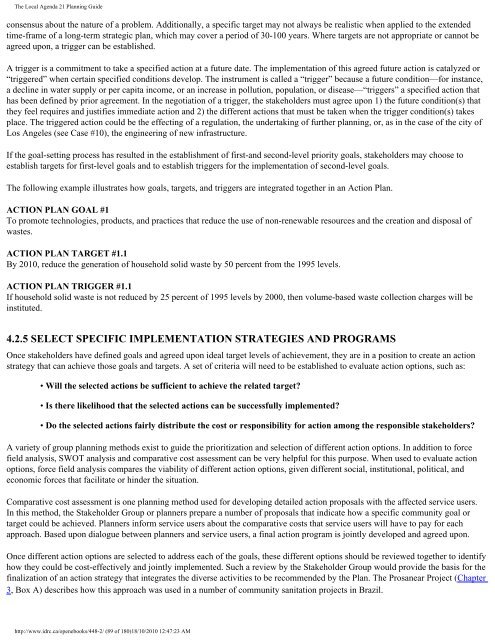The Local Agenda 21 Planning Guide - Democrats Against UN ...
The Local Agenda 21 Planning Guide - Democrats Against UN ...
The Local Agenda 21 Planning Guide - Democrats Against UN ...
You also want an ePaper? Increase the reach of your titles
YUMPU automatically turns print PDFs into web optimized ePapers that Google loves.
<strong>The</strong> <strong>Local</strong> <strong>Agenda</strong> <strong>21</strong> <strong>Planning</strong> <strong>Guide</strong><br />
consensus about the nature of a problem. Additionally, a specific target may not always be realistic when applied to the extended<br />
time-frame of a long-term strategic plan, which may cover a period of 30-100 years. Where targets are not appropriate or cannot be<br />
agreed upon, a trigger can be established.<br />
A trigger is a commitment to take a specified action at a future date. <strong>The</strong> implementation of this agreed future action is catalyzed or<br />
“triggered” when certain specified conditions develop. <strong>The</strong> instrument is called a “trigger” because a future condition—for instance,<br />
a decline in water supply or per capita income, or an increase in pollution, population, or disease—“triggers” a specified action that<br />
has been defined by prior agreement. In the negotiation of a trigger, the stakeholders must agree upon 1) the future condition(s) that<br />
they feel requires and justifies immediate action and 2) the different actions that must be taken when the trigger condition(s) takes<br />
place. <strong>The</strong> triggered action could be the effecting of a regulation, the undertaking of further planning, or, as in the case of the city of<br />
Los Angeles (see Case #10), the engineering of new infrastructure.<br />
If the goal-setting process has resulted in the establishment of first-and second-level priority goals, stakeholders may choose to<br />
establish targets for first-level goals and to establish triggers for the implementation of second-level goals.<br />
<strong>The</strong> following example illustrates how goals, targets, and triggers are integrated together in an Action Plan.<br />
ACTION PLAN GOAL #1<br />
To promote technologies, products, and practices that reduce the use of non-renewable resources and the creation and disposal of<br />
wastes.<br />
ACTION PLAN TARGET #1.1<br />
By 2010, reduce the generation of household solid waste by 50 percent from the 1995 levels.<br />
ACTION PLAN TRIGGER #1.1<br />
If household solid waste is not reduced by 25 percent of 1995 levels by 2000, then volume-based waste collection charges will be<br />
instituted.<br />
4.2.5 SELECT SPECIFIC IMPLEMENTATION STRATEGIES AND PROGRAMS<br />
Once stakeholders have defined goals and agreed upon ideal target levels of achievement, they are in a position to create an action<br />
strategy that can achieve those goals and targets. A set of criteria will need to be established to evaluate action options, such as:<br />
• Will the selected actions be sufficient to achieve the related target?<br />
• Is there likelihood that the selected actions can be successfully implemented?<br />
• Do the selected actions fairly distribute the cost or responsibility for action among the responsible stakeholders?<br />
A variety of group planning methods exist to guide the prioritization and selection of different action options. In addition to force<br />
field analysis, SWOT analysis and comparative cost assessment can be very helpful for this purpose. When used to evaluate action<br />
options, force field analysis compares the viability of different action options, given different social, institutional, political, and<br />
economic forces that facilitate or hinder the situation.<br />
Comparative cost assessment is one planning method used for developing detailed action proposals with the affected service users.<br />
In this method, the Stakeholder Group or planners prepare a number of proposals that indicate how a specific community goal or<br />
target could be achieved. Planners inform service users about the comparative costs that service users will have to pay for each<br />
approach. Based upon dialogue between planners and service users, a final action program is jointly developed and agreed upon.<br />
Once different action options are selected to address each of the goals, these different options should be reviewed together to identify<br />
how they could be cost-effectively and jointly implemented. Such a review by the Stakeholder Group would provide the basis for the<br />
finalization of an action strategy that integrates the diverse activities to be recommended by the Plan. <strong>The</strong> Prosanear Project (Chapter<br />
3, Box A) describes how this approach was used in a number of community sanitation projects in Brazil.<br />
http://www.idrc.ca/openebooks/448-2/ (89 of 180)18/10/2010 12:47:23 AM










